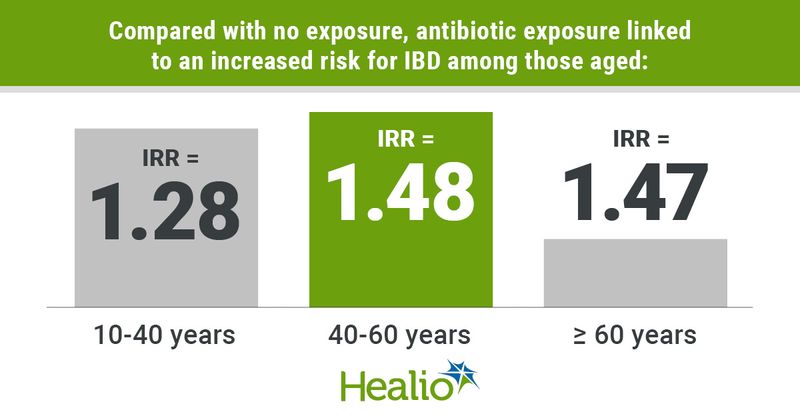Frequent antibiotic use raises risk for IBD, particularly in older adults
Click Here to Manage Email Alerts
Antibiotic exposure was associated with an increased and cumulative risk for inflammatory bowel disease and was highest among individuals aged 40 years and older, according to results from a Danish study published in Gut.
“From prior data, it seems that the environment may play an increasing role in the pathogenesis of IBD as we age. We think this because older adults with new onset IBD are less likely to have a positive family history [of IBD] as compared to younger adults with new onset IBD,” Adam S. Faye, MD, MS, assistant professor of medicine and population health at NYU Grossman School of Medicine, told Healio. “Additionally, prior data has shown an association between antibiotic use and the development of IBD in younger patients, but there is little data exploring the role of antibiotics in the development of IBD among older adults.”

Using data from the Danish Civil Registration System (January 2000-December 2018), Faye and colleagues conducted a nationwide, population-based cohort study to evaluate the incidence rate ratio (IRR) for IBD following antibiotic treatment in residents aged 10 years and older with no previous diagnosis of IBD. Researchers assessed the dose-response relationship between antibiotic exposure and IBD development, the risk for Crohn’s disease and ulcerative colitis, and the impact of antibiotic timing and different antibiotic classes on IBD development.
They enrolled 6,104,245 individuals (50.4% women), which resulted in 87,112,328 person-years of follow-up. During the study period, 90.9% of individuals received at least one course of antibiotics, and researchers reported 36,017 new cases of UC and 16,881 new cases of CD.
Compared with no antibiotic exposure, any antibiotic exposure was associated with an increased risk for IBD across all age groups, but particularly among those aged 40 years and older (10-40 years: IRR = 1.28; 95% CI, 1.25-1.32; 40-60 years: IRR = 1.48; 95% CI, 1.43-1.54; and 60 years and older: IRR = 1.47; 95% CI, 1.42-1.53). Researchers noted a “slightly higher” risk for CD compared with UC.
Moreover, each subsequent course of antibiotics increased the risk for IBD across age groups (IRR = 1.11; 95% CI, 1.1-1.12; IRR = 1.15; 95% CI, 1.14-1.16; and IRR = 1.14; 95% CI, 1.13-1.15, respectively), with the highest risk among those who received five or more courses of antibiotics. The highest risk for IBD development was 1 to 2 years following antibiotic exposure.

“Antibiotics commonly used to treat gastrointestinal infections were associated with the highest risk of developing IBD,” Faye told Healio. “However, nitrofurantoin, an antibiotic that has minimal impact on the intestinal microbiome and is often used to treat UTIs, was not associated with an increased risk.”
Specifically, antibiotics associated with the greatest risk for IBD development included nitroimidazoles (IRR = 1.13; 95% CI, 1.19-1.42; IRR = 1.43; 95% CI, 1.28-1.58; and IRR = 1.61; 95% CI, 1.41-1.83) and fluroquinolones (IRR = 1.76; 95% CI, 1.6-1.93, IRR = 1.79; 95% CI, 1.61-1.97 and IRR = 1.54; 95% CI, 1.41-1.69).
“One of the main takeaways is not to avoid antibiotics when needed, but in those cases where an illness may be self-limiting, empirically prescribing an antibiotic — when not indicated — may have more harm than benefit,” Faye said. “It is important to remember that antibiotics, including ones not used to treat gastrointestinal infections, can alter the microbiome.”
He added, “It is important to consider IBD in older adults with ongoing GI symptoms, particularly if there is a history of antibiotic use.”
